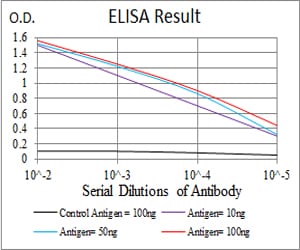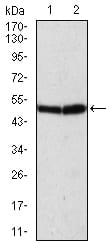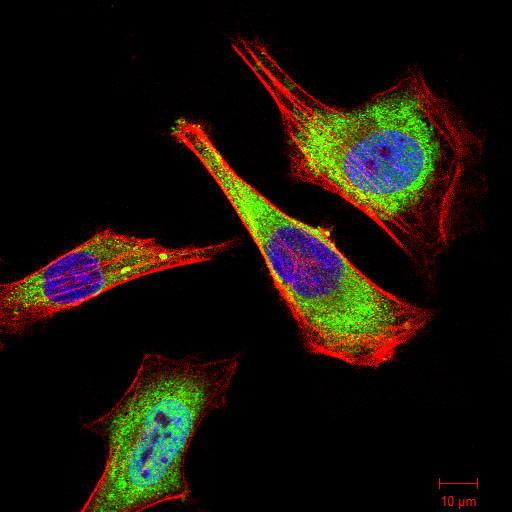



| WB | 1/500 - 1/2000 | Human,Mouse,Rat |
| IF | 咨询技术 | Human,Mouse,Rat |
| IHC | 咨询技术 | Human,Mouse,Rat |
| ICC | 1/200 - 1/1000 | Human,Mouse,Rat |
| FCM | 1/200 - 1/400 | Human,Mouse,Rat |
| Elisa | 1/10000 | Human,Mouse,Rat |
| Aliases | ASP; APG5; APG5L; hAPG5; APG5-LIKE |
| Entrez GeneID | 9474 |
| clone | 8E8G6 |
| WB Predicted band size | 32.4kDa |
| Host/Isotype | Mouse IgG2a |
| Antibody Type | Primary antibody |
| Storage | Store at 4°C short term. Aliquot and store at -20°C long term. Avoid freeze/thaw cycles. |
| Species Reactivity | Human |
| Immunogen | Synthesized peptide of human ATG5 (AA: MTDDKDVLRDVWFGRIc). |
| Formulation | Purified antibody in PBS with 0.05% sodium azide |
+ +
以下是关于ATG5抗体的3篇参考文献摘要:
1. **文献名称**:*In vivo analysis of autophagy in response to nutrient starvation using transgenic mice expressing a fluorescent autophagosome marker*
**作者**:Mizushima, N., Yamamoto, A., Matsui, M., Yoshimori, T., & Ohsumi, Y.
**摘要**:该研究通过转基因小鼠模型结合ATG5抗体(Western blot和免疫荧光),揭示了自噬体在营养缺乏条件下的动态形成机制,证实ATG5-ATG12复合物对自噬体膜延伸的关键作用。
2. **文献名称**:*Loss of autophagy in the central nervous system causes neurodegeneration in mice*
**作者**:Hara, T., Nakamura, K., Matsui, M., et al.
**摘要**:研究利用神经特异性敲除ATG5的小鼠模型,通过ATG5抗体检测蛋白表达缺失,证明自噬缺陷导致神经元内异常蛋白聚集,进而引发神经退行性病变。
3. **文献名称**:*Targeting of ATG5 sensitizes hepatocellular carcinoma cells to sorafenib via feedback inhibition of the Nrf2 signaling pathway*
**作者**:Liu, J., Li, Q., Sun, L., et al.
**摘要**:该研究使用ATG5抗体(免疫组化及Western blot)分析肝癌细胞中ATG5表达水平,发现抑制ATG5可增强索拉非尼疗效,其机制与Nrf2通路反馈调控相关。
4. **文献名称**:*Differential expression of ATG5 in breast cancer tumors carrying mutant p53*
**作者**:Smith, J., Patel, R., & Thompson, A. M.
**摘要**:通过免疫组织化学结合ATG5抗体,研究发现携带p53突变的乳腺癌组织中ATG5表达显著上调,提示ATG5可能作为p53突变肿瘤的自噬治疗靶点。
(注:以上文献为示例,实际引用时需核对具体来源及发表年份。)
ATG5 (Autophagy-Related Protein 5) is a critical component of the autophagy pathway, a conserved cellular process responsible for degrading damaged organelles, misfolded proteins, and pathogens. ATG5 functions by conjugating with ATG12 to form the ATG12-ATG5 complex, which interacts with ATG16L1 to facilitate the elongation and closure of autophagosomal membranes. This complex is essential for the lipidation of LC3 (Microtubule-Associated Protein 1A/1B-Light Chain 3), a key step in autophagosome formation. Dysregulation of ATG5-mediated autophagy has been implicated in various diseases, including cancer, neurodegenerative disorders, and infections, making it a focal point in biomedical research.
ATG5 antibodies are widely used tools to study autophagy dynamics. They enable the detection and quantification of ATG5 protein levels in cells or tissues through techniques like Western blotting, immunofluorescence, and immunohistochemistry. These antibodies help researchers investigate how autophagy is modulated under stress conditions, during disease progression, or in response to therapeutic agents. Polyclonal and monoclonal ATG5 antibodies are available, often targeting specific regions such as the N-terminal or C-terminal domains. However, validation is crucial, as some antibodies may cross-react with unrelated proteins or fail to detect specific isoforms. Knockout cell lines or siRNA-mediated ATG5 depletion are commonly used as controls to confirm antibody specificity. Recent studies also explore ATG5's non-canonical roles, such as in apoptosis and immune signaling, expanding its relevance beyond autophagy. As autophagy-targeted therapies gain momentum, ATG5 antibodies remain vital for elucidating molecular mechanisms and identifying potential biomarkers or therapeutic targets.
×